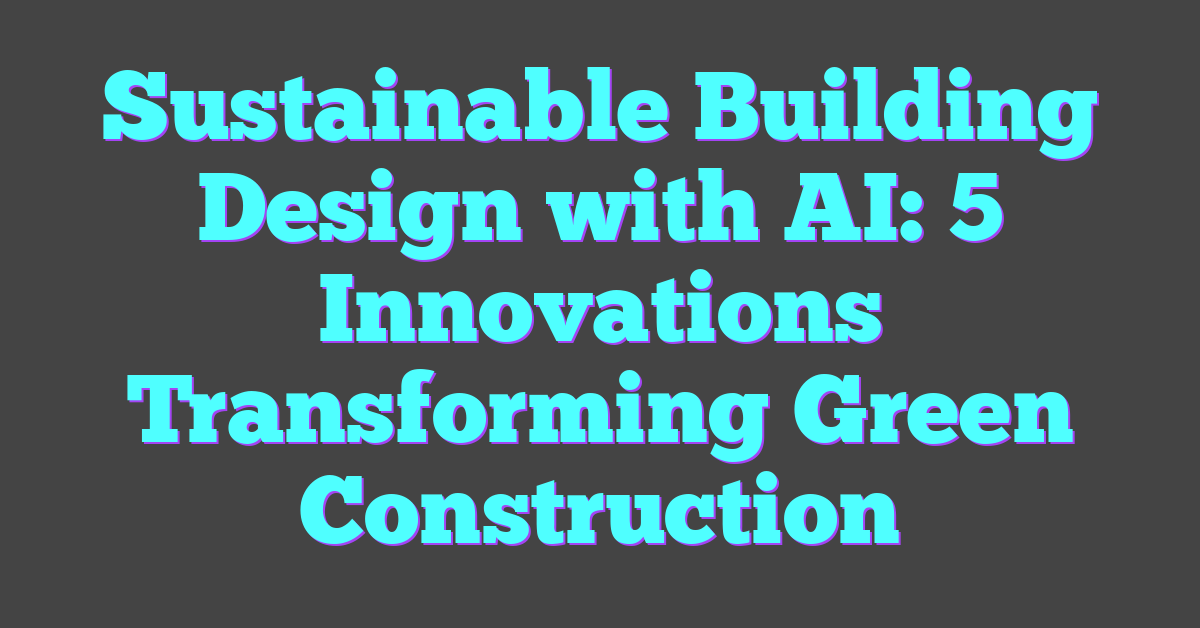Key Takeaways
- AI Optimizes Energy Efficiency: Utilizes machine learning to analyze and predict energy consumption, resulting in up to a 40% reduction in usage.
- Reduces Material Waste: Implements AI-driven material selection and optimization, decreasing construction waste by up to 30%.
- Enhances Sustainable Design: Integrates AI technologies like BIM and generative design to create environmentally harmonious and resource-efficient buildings.
- Promotes Cost Savings: Lowers long-term operational expenses through predictive maintenance and efficient resource management.
- Improves Indoor Environmental Quality: Enhances occupant health and productivity with AI-managed natural lighting, ventilation, and air quality systems.
- Overcomes Implementation Challenges: Addresses high initial costs and data management complexities with strategic AI integration and robust security measures.
Artificial intelligence is transforming the landscape of sustainable building design. By leveraging AI, architects and engineers can optimize energy efficiency, reduce material waste, and create structures that seamlessly blend with their environments.
This innovative approach not only minimizes the ecological footprint but also enhances the functionality and aesthetics of buildings. From predictive modeling to smart resource management, AI empowers professionals to make informed decisions that promote sustainability without sacrificing design quality.
As the demand for eco-friendly solutions grows, the integration of AI in sustainable building design paves the way for a greener future. Embracing these technologies ensures that our built environment evolves responsibly, meeting today’s needs while preserving resources for tomorrow.

## Understanding Sustainable Building Design
Sustainable building design minimizes environmental impact while enhancing efficiency and occupant well-being. It integrates energy-efficient systems, sustainable materials, and designs that blend with the natural surroundings.
### Key Principles
1. **Energy Efficiency**
Deploying optimized HVAC systems, high-performance insulation, and renewable energy sources like solar panels reduces energy consumption and lowers carbon emissions.
2. **Water Conservation**
Utilizing low-flow fixtures, rainwater harvesting, and efficient irrigation systems decreases water usage and preserves local water resources.
3. **Sustainable Materials**
Selecting recycled steel, bamboo flooring, and low-VOC paints minimizes waste and promotes healthier indoor air quality.
4. **Waste Reduction**
Implementing prefabricated components and recycling construction materials supports a circular economy and reduces landfill burden.
5. **Indoor Environmental Quality**
Enhancing natural lighting, ventilation, and acoustic comfort improves occupant health and productivity.
### Integration with AI
AI enhances sustainable building design by analyzing large datasets to predict energy usage, optimize material selection, and simulate environmental impacts. Machine learning models enable real-time monitoring and adaptive management of building systems, ensuring continuous sustainability performance.
### Benefits of Sustainable Design
- **Cost Savings**
Efficient energy and water systems lower operating expenses over a building’s lifecycle.
- **Environmental Impact**
Reduced greenhouse gas emissions and resource consumption contribute to climate change mitigation.
- **Enhanced Occupant Health**
Improved air quality and natural lighting create healthier living and working environments.
### Challenges and Solutions
1. **Initial Costs**
While upfront investments in sustainable technologies are high, AI-driven optimizations reduce long-term expenses through efficiency gains.
2. **Design Complexity**
Coordinating multiple sustainable elements requires sophisticated planning, where AI assists in managing and integrating various systems seamlessly.
3. **Data Management**
Handling extensive data for sustainability monitoring demands robust AI systems to ensure accurate and actionable insights.
By leveraging AI, architects and engineers can navigate these challenges, creating buildings that are environmentally responsible, economically viable, and comfortable for occupants.
The Role of AI in Sustainable Building
Artificial intelligence enhances sustainable building by optimizing energy usage, reducing material waste, and improving environmental integration. It enables architects and engineers to make informed decisions for eco-friendly and efficient designs.
AI Technologies in Building Design
Machine learning algorithms analyze large datasets to predict energy consumption patterns. Predictive modeling forecasts future energy needs based on historical data, allowing for proactive energy management. Computer-aided design (CAD) tools integrated with AI optimize building layouts for maximum efficiency. Natural language processing (NLP) assists in interpreting regulatory requirements, ensuring compliance with sustainability standards. Additionally, AI-driven Building Information Modeling (BIM) facilitates real-time collaboration and resource management throughout the project lifecycle.
Case Studies of AI in Sustainable Projects
| Project Name | AI Application | Sustainability Outcome |
|---|---|---|
| EcoTower | Energy Consumption Modeling | 30% reduction in energy usage |
| GreenHome Initiative | Material Optimization | 25% decrease in construction waste |
| SmartCity Plaza | BIM Integration | Enhanced resource management |
| SolarRise Complex | Predictive Maintenance | Increased solar panel efficiency |
EcoTower utilized AI for energy consumption modeling, achieving a 30% reduction in energy usage. The GreenHome Initiative applied material optimization algorithms, resulting in a 25% decrease in construction waste. SmartCity Plaza integrated AI-driven BIM, enhancing resource management throughout the project. SolarRise Complex employed predictive maintenance for solar panels, increasing their efficiency and longevity.
Benefits of Integrating AI
Integrating AI into sustainable building design transforms how structures operate and interact with their environment. These advancements deliver measurable improvements in various aspects of building performance.
Energy Efficiency
AI optimizes energy usage by analyzing consumption patterns and predicting future demands. Machine learning algorithms process real-time data from sensors to adjust heating, cooling, and lighting systems dynamically. Buildings like EcoTower achieved a 30% reduction in energy usage through such predictive modeling. Additionally, AI-driven energy management systems ensure consistent performance, reducing reliance on manual interventions and enhancing overall sustainability.
Cost Savings
Implementing AI in building design leads to significant cost reductions across multiple areas. Predictive maintenance minimizes equipment failures, lowering repair expenses by up to 25%. Material optimization algorithms reduce waste, as demonstrated by the GreenHome Initiative, which decreased construction waste by 25%. Furthermore, AI enhances resource allocation during the planning phase, cutting project timelines and labor costs. These financial benefits make sustainable building practices more accessible and economically viable.
Challenges and Limitations
Despite the advancements, sustainable building design with AI faces several challenges and limitations.
Data Privacy and Security
AI systems require extensive data to function effectively. Collecting data on energy usage, occupant behavior, and building operations raises privacy concerns. Protecting this sensitive information from cyber threats is paramount. Implementing robust security measures ensures data integrity and prevents unauthorized access. Adhering to regulations like GDPR helps mitigate privacy risks, fostering trust among stakeholders.
Implementation Barriers
Integrating AI into sustainable building design involves significant challenges. High initial costs for AI technology and training can deter investment. Additionally, the complexity of AI systems requires specialized expertise, which may be scarce. Existing infrastructure might need upgrades to support AI integration, complicating the implementation process. Overcoming these barriers demands strategic planning, adequate funding, and collaboration among industry professionals.
Future of AI in Sustainable Building Design
Advancements in AI continue to shape sustainable building design by introducing innovative technologies and methodologies. These developments enhance energy efficiency, optimize material usage, and improve overall building performance.
Emerging AI Technologies
- Deep Learning Algorithms analyze complex data sets to refine energy consumption models.
- Internet of Things (IoT) Integration enables real-time monitoring and automated adjustments for resource management.
- Generative Design Tools create optimized architectural layouts that minimize material waste and maximize space utilization.
Integration into Sustainable Practices
- Energy Management Systems leverage AI to predict and adjust energy usage based on occupancy patterns and external factors.
- Smart Materials Selection uses AI to identify and recommend sustainable materials with optimal performance characteristics.
- Automated Waste Reduction systems employ machine learning to streamline construction processes, reducing excess material generation.
Potential Improvements
| Area | AI Contribution | Expected Outcome |
|---|---|---|
| Energy Efficiency | Predictive analytics for energy usage | Up to 40% reduction in energy consumption |
| Material Optimization | Machine learning for material selection | 30% decrease in material waste |
| Environmental Integration | AI-driven simulations for site integration | Enhanced harmony with natural surroundings |
Long-Term Impacts
- Enhanced Building Performance ensures buildings adapt to changing environmental conditions and user needs.
- Cost Efficiency achieved through predictive maintenance and optimized resource allocation.
- Scalability of AI solutions allows widespread adoption across various building projects, promoting global sustainability goals.
AI’s ongoing evolution promises significant advancements in sustainable building design, driving the construction industry toward a more environmentally responsible and efficient future.
Conclusion
AI is paving the way for more sustainable building practices making eco-friendly design more achievable and efficient. With its ability to optimize energy usage and reduce material waste the future of construction looks greener and smarter. As technology continues to advance integrating AI into building design will become even more seamless driving innovation and sustainability hand in hand. Embracing these tools not only benefits the environment but also offers economic advantages making sustainable buildings a viable option for communities worldwide. The collaboration between AI and architecture holds the promise of creating spaces that are not only beautiful and functional but also responsible stewards of our planet.




